When it comes to digital security, many businesses employ measures that keep their systems largely secure. One area some may struggle with is ensuring that their communication, primarily email, is secure when it leaves the company. In an effort to enhance email security, Microsoft has recently introduced an update to its email encryption system, available to Office 365 users.
In late November, Microsoft introduced Office 365 Message Encryption, which allows business users of Office 365 to send encrypted emails. This is actually a new version of an existing encryption service called Exchange Hosted Encryption (EHE).
The idea of EHE and the new version, Message Encryption, is that it allows businesses to send secure communication in the form of an email. The new version includes some interesting features that not only make sending encrypted messages easier but also more secure. The two biggest features introduced are:
- The ability to send encrypted emails outside of the organization – If you need to send sensitive information outside of your business, you will be able to do so, regardless of what email service the recipient uses.
- The ability to apply your company’s branding to messages – When you encrypt a message, it is sent as an attachment, with a note telling the recipient that it is encrypted and how they should open it. You can add your company’s name to the message so the recipient knows it is legitimate.
When Will Office 365 Message Encryption Be Available?
According to Microsoft, Message Encryption will be available for purchase in the first quarter of 2014. If your company already uses EHE, you will receive the update at some point in the first few months of 2014. Businesses that use E3 and E4 versions of Office 365 will receive the update for free, while other users can purchase it for USD$2 a month per user.
If you don’t use Office 365, but have a system that runs on Microsoft Exchange Online servers, you will also be able to purchase and install Message Encryption.
How Will This Work?
If you choose to implement Message Encryption, your administrator will have to select and apply the level and type of encryption and related rules they want to apply to emails. When you send an email that meets the set rules or requirements, it will be automatically encrypted.
Your email will be encrypted as it leaves your email system and before it is delivered. The recipient will receive an email with the body of the email you sent attached. There will also be a set of instructions on how to access the email. This will usually open the email in a new window that looks like the Outlook Web App. If the user replies to the email or forwards it, the encryption will remain in place.
If you are looking to learn more about how this service can be used in your business, or other ways you can keep your communications secure, please contact us today.
Published on 28th October 2013 by Jeanne DeWitt.


